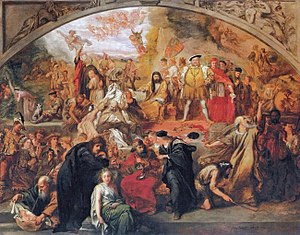
Thousands of performances of William Shakespeare's plays have been staged since the end of the 16th century. While Shakespeare was alive, many of his greatest plays were performed by the Lord Chamberlain's Men and King's Men acting companies at the Globe and Blackfriars Theatres.[1][2] Among the actors of these original performances were Richard Burbage (who played the title role in the first performances of Hamlet, Othello, Richard III and King Lear),[3] Richard Cowley, and William Kempe.
Shakespeare's plays continued to be staged after his death until the Interregnum (1642–1660), when most public stage performances were banned by the Puritan rulers. After the English Restoration, Shakespeare's plays were performed in playhouses, with elaborate scenery, and staged with music, dancing, thunder, lightning, wave machines, and fireworks. During this time the texts were "reformed" and "improved" for the stage, an undertaking which has seemed shockingly disrespectful to posterity.
Victorian productions of Shakespeare often sought pictorial effects in "authentic" historical costumes and sets. The staging of the reported sea fights and barge scene in Antony and Cleopatra was one spectacular example.[4] Such elaborate scenery for the frequently changing locations in Shakespeare's plays often led to a loss of pace. Towards the end of the 19th century, William Poel led a reaction against this heavy style. In a series of "Elizabethan" productions on a thrust stage, he paid fresh attention to the structure of the drama. In the early 20th century, Harley Granville-Barker directed quarto and folio texts with few cuts,[5] while Edward Gordon Craig and others called for abstract staging. Both approaches have influenced the variety of Shakespearean production styles seen today.[6]
- ^ Editor's Preface to A Midsummer Night's Dream by William Shakespeare, Simon and Schuster, 2004, p. xl
- ^ Foakes, 6.
• Nagler, A.M (1958). Shakespeare's Stage. New Haven, CT: Yale University Press, 7. ISBN 0-300-02689-7.
• Shapiro, 131–32. - ^ Ringler, William jr. "Shakespeare and His Actors: Some Remarks on King Lear" from Lear from Study to Stage: Essays in Criticism edited by James Ogden and Arthur Hawley Scouten, Fairleigh Dickinson Univ Press, 1997, p. 127.
King,T.J. (Thomas J. King Jr.) (1992). Casting Shakespeare's Plays; London actors and their roles 1590–1642, Cambridge University Press. ISBN 0-521-32785-7 (Paperback edition 2009, ISBN 0-521-10721-0) - ^ Halpern (1997). Shakespeare Among the Moderns. New York: Cornell University Press, 64. ISBN 0-8014-8418-9.
- ^ Griffiths, Trevor R (ed.) (1996). A Midsummer Night's Dream. William Shakespeare. Cambridge: Cambridge University Press; Introduction, 2, 38–39. ISBN 0-521-57565-6.
• Halpern, 64. - ^ Bristol, Michael, and Kathleen McLuskie (eds.). Shakespeare and Modern Theatre: The Performance of Modernity. London; New York: Routledge; Introduction, 5–6. ISBN 0-415-21984-1.